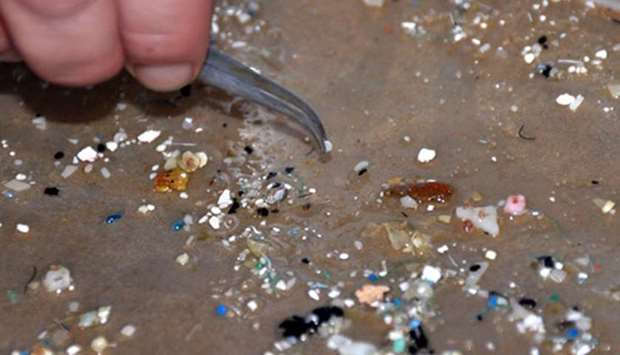Scientists are warning that microplastics in the ocean and the toxic chemicals in them are posing a significant risk to giant animals like whales, sharks, and manta rays that are marine filter feeders.
Such animals swallow thousands of cubic metres of seawater daily in an effort to capture plankton, in which case they can ingest microplastics directly from polluted water or indirectly through contaminated prey, the scientific analysis published in the journal Trends in Ecology & Evolution said.
It said plastic-associated chemicals and pollutants can accumulate over decades and alter biological processes in the animals, leading to altered growth, development and reproduction, including reduced fertility.
‘While a definitive connection between microplastic ingestion and toxin exposure for filter feeders remains to be confirmed, studies into seabirds and small fish have found a link,’ Elitza Germanov, the lead researcher of the study, said in an email statement.
The marine species are also in danger due to their habitat areas overlapping microplastic pollution hotspots like the Gulf of Mexico, the Mediterranean Sea, the Bay of Bengal and the Coral Triangle - an area from Malaysia to the Solomon Islands in the Pacific.
Microplastics are small plastic pieces less than five millimetres long, which are harmful to marine life.
Many of the animals, like manta rays, are threatened species, so it is difficult to assess plastic concentrations via conventional methods such as stomach analysis, Germanov said.
‘So we are using the non-lethal sampling of small amounts of tissue, which we are testing for chemical tracers using sophisticated and sensitive analytical tools,’ she said.
Many of the filter-feeding animals live a long life but have few offspring throughout their lives.
Maria Cristina Fossi, a co-author of the study, said another study she led on whale sharks in the Gulf of California and on fin whales in the Mediterranean Sea confirmed exposure to toxic chemicals.
‘As these areas are hotspots for microplastics, our results could indicate that filter feeders are taking up microplastics in their feeding grounds,’ she said.
Her study estimated that whale sharks may be ingesting 171 items on a daily basis, after finding an average of 0.7 plastic items per cubic meter of water around the Baja California peninsula, an important feeding ground for endangered whale sharks.
Germanov, who is a PhD student at Australia's Murdoch University, said microplastic contamination had the potential to reduce the population of already vulnerable species.
‘As plastic production is projected to increase globally, future research should focus on coastal regions where microplastic pollution overlaps with the critical feeding and breeding grounds of these threatened animals,’ she said.
Lately, there has been a large number of reports and studies on marine life facing an existential threat from the millions of tonnes of plastic waste that ends up in the oceans each year.
Last year, there were reports of a whale found dead with more than 30 whole plastic bags in its stomach in Norway. In France, there were reports of a dead whale carcass with 800 kilograms of plastic inside.
The United Nations Oceans organization has called it ‘a planetary crisis,’ as plastic production is projected to increase globally.
As of 2015, more than 6.3 billion tonnes of plastic waste have been generated. Only 20 per cent of that is recycled or destroyed through incineration. The rest ends up in the natural environment or in landfills.

